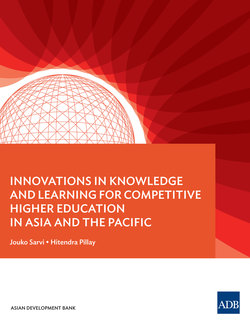Читать книгу Innovations in Knowledge and Learning for Competitive Higher Education in Asia and the Pacific - Jouko Sarvi - Страница 5
На сайте Литреса книга снята с продажи.
Background and Context
ОглавлениеThe global discourse on social development and economic growth in the developing world is guided by a vision about knowledge-based economies wherein knowledge workers play an increasingly important role, and the centrality of “knowledge” underpins competitiveness.1 The ability to innovate and create knowledge—and to find innovative applications of the same—is strongly influenced by the capacity of higher education institutions (HEIs). However, traditional models of HEIs in Asia and the Pacific lack this capacity, which is problematic in a dynamic region with a rapidly increasing number of middle income countries.2 This dynamic growth creates a strong demand for investment in strengthening innovation and development towards a knowledge-based economy.
All over the world, labor market changes, urbanization, and demography have fuelled the boom. The migration of the middle classes into the cities has provided increased access to higher education, despite which rising numbers of young people are facing unemployment and—especially in Arab countries— combustible politics increase the need to offer opportunities to disillusioned youths. Increased access to traditional higher education and increased gross domestic product3 growth do not directly translate to job creation or to increased employment and productivity. Therefore, with the ability to be innovative and create new jobs, knowledge-based industries will be able to provide a competitive advantage to HEIs.
The “knowledge economy” has increased the demand for workers with well-furnished minds who are able not only to apply existing knowledge, but also to innovate and create knowledge that stimulates new enterprises. We are in the midst of an increasingly rapid transformation in education, across dimensions of purpose, content, pedagogy, and methodologies. Technology, social change, increased demand, and the decades-long trend of ever-increasing costs and very supply-side planning have left us with multiple challenges and the need to be highly innovative in an educational culture that tends to be wary of change.
The challenge in higher education is stimulated by the need to focus more on increasing access to higher education, on student learning, and on opportunities to accelerate and improve learning in line with the needs of countries. The human resource capacity needs of countries cannot be determined by using knowledge lenses derived from the industrial revolution or the information age. Therefore, any comprehensive analysis of access to student learning should also include revisiting the issues of how demand for knowledge and learning processes is changing and the ways HEIs can improve their organization and function to respond to the changing demands.4
In this context, the issues of knowledge can be summarized under three key understandings, discussed in the next section. These have implications across all the three key functions of contemporary HEIs: teaching and learning (knowledge construction and acquisition), research (knowledge creation and application), and community engagement (knowledge applications and value adding).
